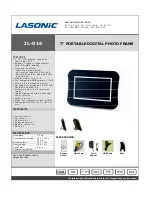
4
3B.
Attaching Camera to Tripod or Stand
To mount the camera, attach the Focus Block (16) to your tripod or stand fitted with a 3/8” mounting thread.
(NOTE: Use of a ¼-20 reducer bushing is not recommended.) Secure tightly. If using a tripod head, level the
camera using the spirit levels (15,18) in the Focus Block (16). Unlock the Shift Profile (17) using the Focus
locking knob (13) by turning it counter-clockwise. Check if the Shift Profile can be shifted all the way
backwards (approximately 63mm on left focus scale (27) reading from behind the camera). If the camera
construction touches the tripod or stand, use the 3/8” hole that is closer to the rear of the Focus Block (16).
NOTE: All “right” and “left” references in this instruction guide are made from standing behind the camera.
3C.
Attaching the Bellows
Take the bellows and place the bellows front
ring (28) behind the Base Bracket (9) of the
Lens Plate Housing (4). Push the locking
lever (5) at the indicated Bellows “Button”.
Then push the bellows ring inside the
Housing and release the locking lever,
locking the ring.
3D.
Mounting Lens to Lensboard
Depending on what lens is used, the following methods are used mounting a lens to the Lensboard:
- Hasselblad Lens Adapter:
The Lens is placed and locked into the Adapter using the Hasselblad
bayonet system. NOTE: This adapter is recessed and therefore it has no locking system on the bayonet
construction.
- Mamiya 645pro Lens Adapter:
The Lens is placed and locked into the Adapter using the Mamiya
bayonet system. Use the instructions with the adapter for the right positioning of the diaphragm ring.
NOTE: This adapter is recessed and therefore it has no locking system on the bayonet construction.
- Mamiya RB/RZ Lens Adapter:
The Lens is placed and locked into the Adapter using the Mamiya
bayonet system. NOTE: This adapter is has no locking system on the bayonet construction.
- Schneider and Rodenstock lenses with “0” size shutter should be mounted directly to the dedicated flat
X-223 or recessed X-228 lens panel. The 28,72 and 80mm Schneider ApoDigitars should be mounted in
a recessed Lensplate. The 150mm lenses should be mounted on a reversed recessed Lensplate
(extending the camera). For macro purposes and the 150mm lenses a macroconverter is available (see
3F)
3E.
Mounting Lensboard to Camera
Be sure that the X2-Pro camera is mounted correctly and
stable to avoid damaging your lenses / equipment.
Take the Lensboard and place it behind the Base Bracket (9)
of the Lens Plate Housing (4). Push the safety knob (23) of
the locking lever (5) and push the lever at the indicated Lens
“button” (5b). Then push the lensboard inside the Housing
and release the locking lever. Be sure that the Safety Knob
clicks back into the outside position. If necessary push the
Lever at the other side till the safety knob clicks. The
Lensplate now is locked by the ridge (5a).
Lens Plate Lever indicator
9
4
28
5
23
5b
5a
4

























